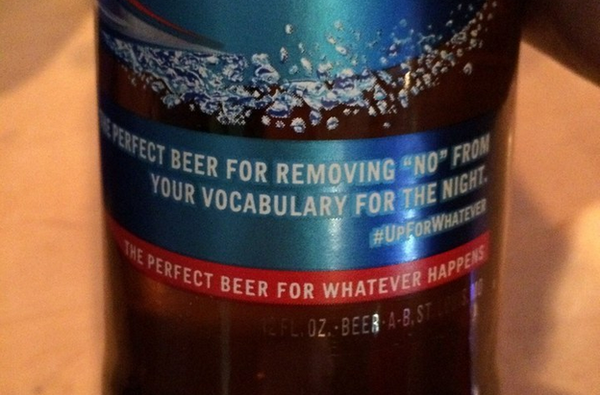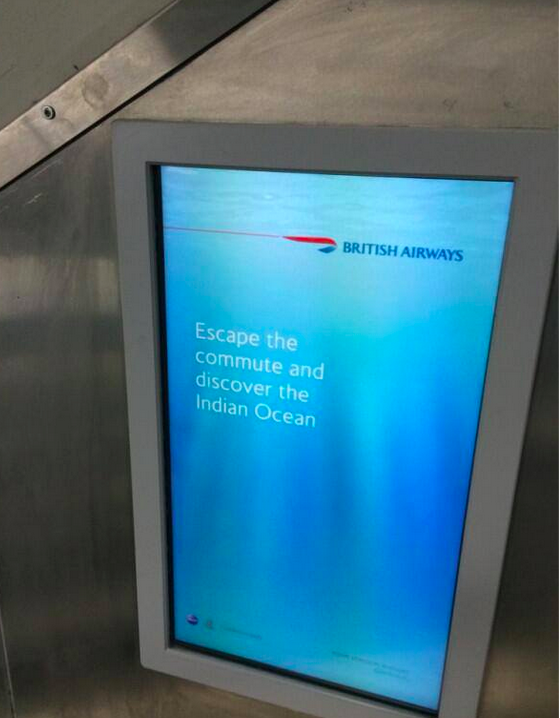I’ve got a question for you. It’s an important question so I really want you to close all distractions and put a good 30 seconds of thought into contemplating it.
My question is… how does something like this happen?

Bud Light’s #UpForWhatever campaign lead them to make the brilliant decision to write “The perfect beer for removing ‘no’ from your vocabulary for the night. #UpForWhatever The perfect beer for whatever happens” on their beer bottles.
Do you see something wrong here? I certainly see a few things – and not only the decision to launch such a complete and utter communications fail, but the fact that this campaign was launched in the first place reveals a lot about Bud Light’s – and their agency’s, if they had help from one – corporate culture. But before I get into that, let’s take a look at what has come as a result of this preventable issue.
As a result of this campaign, Bud Light:
- Is in the process of being labelled “the official beer of rape culture” by the public on social media and beyond;
- Had to publish an official statement and apology for this tactless gaffe;
- Has moved towards positioning themselves as a socially irresponsible and ignorant organization.
Come on people! We keep seeing these senseless, preventable gaffes being made in PR and marketing campaigns (think Teenage Mutant Ninja Turtles, British Airways, US Airways and DiGiorno Pizza just to name a few), which leads me back to my question… How does this happen? And more specifically, how is this permitted to happen, because it is certainly inexcusable.
More thought needs to go into communications campaigns
Last week I gave a keynote address for PRSA’s Strategic Collaboration Conference and, ironically (or not), this topic was a big part of my message. Your organization cannot afford to be making these senseless and socially irresponsible mistakes. And make no mistake about it, unless you have adapted the mindset of continuous risk assessment as a part of your corporate culture, just because you may not have yet experienced this type of issue, in no way means you won’t in the near future.
The fact is that risk assessments need to be conducted on every single campaign both as they’re being created and developed, as well as RIGHT BEFORE they get launched. Both of these steps are critical for your issue and crisis prevention. Why? Let me give you an example…
When British Airways thought up the below campaign it was probably a great idea (of course I’m giving them the benefit of the doubt that this campaign was probably developed months before it was actually launched). However, launching this campaign three weeks after flight MH 370 disappeared somewhere within the vicinity of the Indian Ocean, was NOT a good idea.

This example highlights the fact that it’s not enough to simply assess the risk associated to each and every communication campaign and initiative as their being developed. A second risk assessment needs to be conducted right before the campaign or communication gets launched or published. Think of it as a one-two punch that can save your organization’s reputation from avoidable negative impact.
These types of risk assessments are critical to issue and crisis prevention and it still baffles me that organizations have yet to implement protocols to make them a customary part of all communications efforts and initiatives. This is a mindset that needs to be adapted into the very culture of your organization and establishing these types of mandatory protocols and procedures is the first step towards achieving this.
Another thought on the same note
Additionally, I can’t help but wonder whether or not someone within the Bud Light team did in fact identify this campaign as a red flag and simply didn’t feel empowered to speak up about it. Whether this is true or not, it’s still worth your reflection. Does your organization foster a culture where employees are empowered to speak up and voice their opinions? Are they rewarded for taking such bold initiatives? Your answer to this question just may be the deciding factor on whether or not you end up facing your next issue or crisis.

Author of Crisis Ready: Building an Invincible Brand in an Uncertain World, Melissa Agnes is a leading authority on crisis preparedness, reputation management, and brand protection. Agnes is a coveted keynote speaker, commentator, and advisor to some of today’s leading organizations faced with the greatest risks. Learn more about Melissa and her work here.

Some marketing people have very little appreciation of the potential impact on reputation of what they do. Sadly, cases such as this are only too common and reinforce that public relations and communications professionals skilled in issue identification and crisis prevention need to be directly involved in assessing material issued in the name of their organisation. And that wont happen until top executives provide proper leadership.
You’re right, Tony. Hopefully in our efforts (from blogging, podcasting, speaking engagements and teaching) we can help professionals understand the need for this type of mindset and protocols and inspire them to make some internal changes to adapt them.
Love your articles about the PR gaffes. I think that one contributing factor is a mental state where by everyone wants to be the first to comment, post on Twitter, or Face Book, or any other social media. The “prize” is to post first, and thus after that social media trending will have your link/post at the top of their search engines, which brings in more clicks-throughs and thus more revenue. It’s no longer about accuracy, but about who posted first. I’m hearing it more and more on the news also. “Seen exclusively here on _________ news . . .” or “You’ll only see it here . . . ” Accuracy has fallen by the wayside for speed.
Hi Woody,
You’re right that accuracy does tend to fall by the wayside for speed, though I’ve been starting to see a turnaround where this is concerned. Organizations are beginning to concern themselves with being accurate and transparent over being “the first”. This is certainly a good thing.
In this particular case, however, I think the issue is poor judgement and a lack of a corporate culture of risk assessment, rather than the need for speed. However, the issue of speed and “being first” is certainly an existing concern.
Thanks for taking the time to weigh in!
Melissa
I am guessing that there were no women in the room when this was presented and approved and that the men involved either didn’t have or forgot about their wives, daughters, sisters, mothers.
Hi Sam,
Honestly, I think it was an innocent, yet foolish and regrettable mistake. I think they were looking at the messaging from the way it was intended to be received and lacked the mindset to conduct a risk assessment on it, asking themselves “how can this potentially be misconstrued? What’s the worst that could come of this?” Whether or not there were women who took part in the approval process, I do not know.
Thanks for taking the time to leave your thoughts.
Melissa